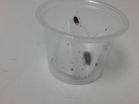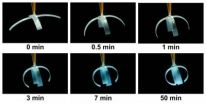(Press-News.org) The risk of developing pelvic inflammatory disease (PID) following insertion of an intrauterine device (IUD) is very low, whether or not women have been screened beforehand for gonorrhea and chlamydia, according to a joint study of nearly 60,000 women by researchers at the University of California, San Francisco (UCSF), and Kaiser Permanente Northern California Division of Research.
The study appears this week in the current online issue of Obstetrics & Gynecology, the official journal of the American College of Obstetricians and Gynecologists, also known as Green Journal.
The findings correct long-standing misperceptions that IUDs cause PID. Also, by evaluating the relationship between the timing of testing for gonorrhea and chlamydia (GC/CT) and the risk of developing PID within 90 days after IUD insertion, the study fills a large gap in the evidence base for the optimal timing and necessity of testing women who have no symptoms of gonorrhea and chlamydia.
Because gonorrhea or chlamydia infection is a risk factor for PID in any woman, there is a concern that inserting an IUD in someone who has an asymptomatic infection could increase that risk of PID. This study shows that protocols that test on the same day as IUD insertion, and then promptly treat women who test positive, do not increase the risk of developing PID compared to women who were screened ahead of time or not at all.
"This study affirms that there is a low risk of pelvic inflammatory disease after IUD insertion, which has the potential to reduce barriers to IUD access, such as making women have a separate screening visit before the IUD insertion," said lead author Carolyn B. Sufrin, MD, MA, of UCSF's Bixby Center for Global Reproductive Health.
"In addition, it provides evidence to support [Centers for Disease Control and Prevention] screening guidelines for gonorrhea and chlamydia in women receiving IUDs. If testing is indicated, our results suggest that it is safe to do so on the day of IUD insertion, with prompt treatment of positive results," said Debbie Postlethwaite, RNP, MPH with the Kaiser Permanente Division of Research in Oakland, Calif.
The researchers explained that the most accurate time to clinically assess and screen for cervical infection is on the day of IUD insertion. They also emphasized that a woman's risk status does not depend on her method of contraception, or when she is screened, but rather on sexual behaviors. Women with high-risk sexual behaviors continue to be at increased risk of GC/CT acquisition even after IUD placement, they said.
"IUDs are among the safest, most effective methods of contraception and provide benefits in managing vaginal bleeding, chronic pelvic pain and a condition called endometriosis, which occurs when cells from the lining of the uterus grow in other areas of the body. Whereas the risk of pregnancy is 9 percent annually with pills, patches and rings, IUDs allow women almost complete control in planning their pregnancies," explained the researchers.
Nonetheless, the use of IUDs for contraception is extremely low in the U.S., particularly in comparison with other countries. The reluctance dates to the 1970s, when the poor design of the Dalkon Shield IUD caused bacterial infection and led to thousands of lawsuits. Although the Dalkon Shield was removed from the market, it had a lasting negative impact on IUD use in the U.S. This lingering fear of PID leads many providers to require a recent negative gonorrhea and chlamydia test before inserting an IUD, creating the need for multiple patient visits.
The study cohort of 57,728 women between the ages of 14 and 49 years had either a levonorgestrel intrauterine system or copper-T IUD inserted for contraceptive or non-contraceptive use at Kaiser Permanente Northern California (KPNC) between Jan. 1, 2005, and Aug. 31, 2009. A major strength of the study is the large number of demographically diverse subjects in an integrated healthcare delivery system with widespread use of IUDs. KPNC's integrated pharmacy, laboratory and medical visit databases, and electronic medical records system were accessed for all study data.
The date of the IUD insertion visit was compared with the most recent gonorrhea and chlamydia screening date to categorize women into four screening groups: 1) screening on the same day as insertion; 2) screening one day up to eight weeks before insertion; 3) screening eight weeks up to one year before insertion; and 4) no screening within one year before insertion.
Although the risk of PID in IUD users is highest in the first 20 days after insertion, 90 days after insertion was chosen as the benchmark in order to be conservative in estimating the risk of PID. PID risks for the gonorrhea and chlamydia screening groups were compared by calculating both unadjusted and adjusted risk differences and odds ratios with 95 percent confidence intervals, with adjustments for age and race, factors known to be associated with PID.
The risk of PID diagnosis within 90 days of IUD insertion in the entire cohort was 0.0054. The risk was highest in the group screened one day to eight weeks before insertion and lowest in the group with no screening, indicating that women who were not screened had an equivalent risk of PID as women who were screened.
INFORMATION:
Additional authors on the study included Mary Anne Armstrong, MA, and Maqdooda Merchant, MSc, MA, of Kaiser Permanente Northern California, Division of Research; Jacqueline Moro Wendt of Kaiser Permanente San Francisco Medical Center; and Jody E. Steinauer, MD, MAS, of University of California, San Francisco, Bixby Center for Global Reproductive Health.
About the UCSF Bixby Center for Global Reproductive Health
The UCSF Bixby Center for Global Reproductive Health was formed in 1999 to address the health, social and economic consequences of sex and reproduction through research and training in contraception, family planning and STIs. The Bixby Center strives to develop preventive solutions to the most pressing domestic and international reproductive health problems. Its mission is to advance women's health worldwide through research, training, policy analysis and services. For more information, visit www.http://bixbycenter.ucsf.edu.
About University of California, San Francisco
UCSF is a leading university dedicated to promoting health worldwide through advanced biomedical research, graduate-level education in the life sciences and health professions, and excellence in patient care. For further information, visit www.ucsf.edu.
About the Kaiser Permanente Division of Research
The Kaiser Permanente Division of Research conducts, publishes and disseminates epidemiologic and health services research to improve the health and medical care of Kaiser Permanente members and the society at large. It seeks to understand the determinants of illness and well-being, and to improve the quality and cost-effectiveness of health care. Currently, DOR's 500-plus staff is working on more than 250 epidemiological and health services research projects. For more information, visit www.dor.kaiser.org.
About Kaiser Permanente
Kaiser Permanente is committed to helping shape the future of health care. We are recognized as one of America's leading health care providers and not-for-profit health plans. Founded in 1945, our mission is to provide high-quality, affordable health care services to improve the health of our members and the communities we serve. We currently serve 8.6 million members in nine states and the District of Columbia. Care for members and patients is focused on their total health and guided by their personal physicians, specialists and team of caregivers. Our expert and caring medical teams are empowered and supported by industry-leading technology advances and tools for health promotion, disease prevention, state-of-the art care delivery and world-class chronic disease management. Kaiser Permanente is dedicated to care innovations, clinical research, health education and the support of community health. For more information, visit www.kp.org/newscenter.
Follow UCSF
UCSF.edu | Facebook.com/ucsf | Twitter.com/ucsf | YouTube.com/ucsf
IUDs don't cause pelvic inflammatory disease in women
New UCSF/Kaiser Permanente study shows low risk following insertion of intrauterine devices with same-day screening
2012-11-21
ELSE PRESS RELEASES FROM THIS DATE:
New electrically-conductive polymer nanoparticles can generate heat to kill colorectal cancer cells
2012-11-21
WINSTON-SALEM, N.C., – Nov. 20, 2012 – Researchers at Wake Forest Baptist Medical Center have modified electrically-conductive polymers, commonly used in solar energy applications, to develop revolutionary polymer nanoparticles (PNs) for a medical application. When the nanoparticles are exposed to infrared light, they generate heat that can be used to kill colorectal cancer cells.
The study was directed by Assistant Professor of Plastic and Reconstructive Surgery, Nicole H. Levi-Polyachenko, Ph.D., and done in collaboration with colleagues at the Center for Nanotechnology ...
Natural fungus may provide effective bed bug control
2012-11-21
UNIVERSITY PARK, Pa. -- "And don't let the bed bugs bite" is no longer a harmless adage. In reality today, these bloodthirsty bugs infest thousands of homes. According to a team of Penn State entomologists, biopesticides -- naturally occurring microorganisms -- might provide an answer to this pest problem.
Bed bugs need blood meals for growth and development throughout their life cycle. Increased travel, widespread insecticide resistance and changes in management practices have caused a resurgence in those insects throughout North America and Europe. Compounding the problem ...
Scotch tape finds new use as grasping 'smart material'
2012-11-21
WEST LAFAYETTE, Ind. – Scotch tape, a versatile household staple and a mainstay of holiday gift-wrapping, may have a new scientific application as a shape-changing "smart material."
Researchers used a laser to form slender half-centimeter-long fingers out of the tape. When exposed to water, the four wispy fingers morph into a tiny robotic claw that captures water droplets.
The innovation could be used to collect water samples for environmental testing, said Babak Ziaie, a Purdue University professor of electrical and computer engineering and biomedical engineering.
The ...
Adenotonsillectomy may help resolve obstructive sleep apnea in children with Prader-Willi syndrome
2012-11-21
Children with Prader-Willi syndrome may receive relief from sleep disorders after undergoing an adenotonsillectomy, suggests a new study from Nationwide Children's Hospital published in the November print issue of the Archives of Otolaryngology-Head and Neck Surgery.
"Patients with Prader-Willi syndrome are at risk for sleep disordered breathing as growth hormone commonly used to treat their condition can cause the tonsils and adenoids to enlarge," said the study's lead author Kris Jatana, MD, FAAP, with Otolaryngology Head & Neck Surgery at Nationwide Children's.
"Growth ...
NASA spacecraft observe Nov. 20 solar eruption
2012-11-21
On Nov. 20, 2012, at 7:09 a.m. EST, the sun erupted with a coronal mass ejection or CME. Not to be confused with a solar flare, a CME is a solar phenomenon that can send solar particles into space and can reach Earth one to three days later. When Earth-directed, CMEs can affect electronic systems in satellites and on Earth.
Experimental NASA research models, based on observations from the Solar Terrestrial Relations Observatory (STEREO), show that the Nov. 20 CME left the sun at speeds of 450 miles per second, which is a slow to average speed for CMEs. CMEs can cause ...
MRI shows brain disruption in patients with post-concussion syndrome
2012-11-21
OAK BROOK, Ill. – MRI shows changes in the brains of people with post-concussion syndrome (PCS), according to a new study published online in the journal Radiology. Researchers hope the results point the way to improved detection and treatment for the disorder.
PCS affects approximately 20 percent to 30 percent of people who suffer mild traumatic brain injury (MTBI)—defined by the World Health Organization as a traumatic event causing brief loss of consciousness and/or transient memory dysfunction or disorientation. Symptoms of PCS include headache, poor concentration ...
More help needed to improve smoking cessation services for pregnant women with mental disorders
2012-11-21
Pregnant women with mental health disorders are facing too many barriers to help them quit smoking during pregnancy despite their willingness to accept support, finds a new study published today (21 November) in BJOG: An International Journal of Obstetrics and Gynaecology.
The study, undertaken by researchers at King's College London, looked at referrals to smoking cessation services and what barriers pregnant women with mental health disorders face compared to those women without disorders.
Overall 400 women, who reported smoking at their first appointment, were monitored ...
Harrisburg Pedestrian Deaths Hint At National Trend
2012-11-21
Harrisburg pedestrian deaths hint at national trend
On the morning of October 31, 2012, a 16-year-old girl was struck and killed by a large vehicle in the intersection of South 13th and Sycamore in Harrisburg, Pennsylvania. The fatal accident occurred shortly before 9:00 a.m. as parents walked their children to nearby Foose Elementary School.
Initial news reports indicated that the driver had fled the scene, but he has since been identified and has reportedly been cooperating with the authorities. Investigators are working to determine whether the driver knew he had ...
New California Law Guards Consumers From LTC Insurance Premium Increases
2012-11-21
New California law guards consumers from LTC insurance premium increases
California legislatures recently passed a new law designed to protect consumers from being taken advantage of by insurance companies providing long-term care, or LTC, policies. These insurance policies are designed to provide consumers with assistance funding long-term care facilities like assisted living facilities, nursing homes and home care programs.
Long-term care facilities may be needed when an individual is no longer able to take care of themselves. Insurance companies consider a person ...
Estate Planning: It's for Everybody
2012-11-21
Estate planning: It's for everybody
Pennsylvanians of all ages and income levels, take note: estate planning can benefit you. Many people of modest means believe that only the wealthy need to plan ahead for what will happen to their possessions, but that is a misconception.
Why everyone needs to plan
The future is uncertain, and people cannot predict their life span or when the need for estate planning will arise. It is better to plan early and have decades of peace of mind than to wait until it is too late. Plans can be readily changed throughout a lifetime, so ...
LAST 30 PRESS RELEASES:
Tea linked to stronger bones in older women, while coffee may pose risks
School feeding programs lead to modest but meaningful results
Researchers develop AI Tool to identify undiagnosed Alzheimer's cases while reducing disparities
Seaweed based carbon catalyst offers metal free solution for removing antibiotics from water
Simple organic additive supercharges UV treatment of “forever chemical” PFOA
£13m NHS bill for ‘mismanagement’ of menstrual bleeds
The Lancet Psychiatry: Slow tapering plus therapy most effective strategy for stopping antidepressants, finds major meta-analysis
Body image issues in adolescence linked to depression in adulthood
Child sexual exploitation and abuse online surges amid rapid tech change; new tool for preventing abuse unveiled for path forward
Dragon-slaying saints performed green-fingered medieval miracles, new study reveals
New research identifies shared genetic factors between addiction and educational attainment
Epilepsy can lead to earlier deaths in people with intellectual disabilities, study shows
Global study suggests the underlying problems of ECT patients are often ignored
Mapping ‘dark’ regions of the genome illuminates how cells respond to their environment
ECOG-ACRIN and Caris Life Sciences unveil first findings from a multi-year collaboration to advance AI-powered multimodal tools for breast cancer recurrence risk stratification
Satellite data helps UNM researchers map massive rupture of 2025 Myanmar earthquake
Twisting Spins: Florida State University researchers explore chemical boundaries to create new magnetic material
Mayo Clinic researchers find new hope for toughest myeloma through off-the-shelf immunotherapy
Cell-free DNA Could Detect Adverse Events from Immunotherapy
American College of Cardiology announces Fuster Prevention Forum
AAN issues new guideline for the management of functional seizures
Could GLP-1 drugs affect risk of epilepsy for people with diabetes?
New circoviruses discovered in pilot whales and orcas from the North Atlantic
Study finds increase in risk of binge drinking among 12th graders who use 2 or more cannabis products
New paper-based technology could transform cancer drug testing
Opioids: clarifying the concept of safe supply to save lives
New species of tiny pumpkin toadlet discovered in Brazil highlights need for conservation in the mountain forests of Serra do Quiriri
Reciprocity matters--people were more supportive of climate policies in their country if they believed other countries were making significant efforts themselves
Stanford Medicine study shows why mRNA-based COVID-19 vaccines can cause myocarditis
Biobanking opens new windows into human evolution
[Press-News.org] IUDs don't cause pelvic inflammatory disease in womenNew UCSF/Kaiser Permanente study shows low risk following insertion of intrauterine devices with same-day screening



